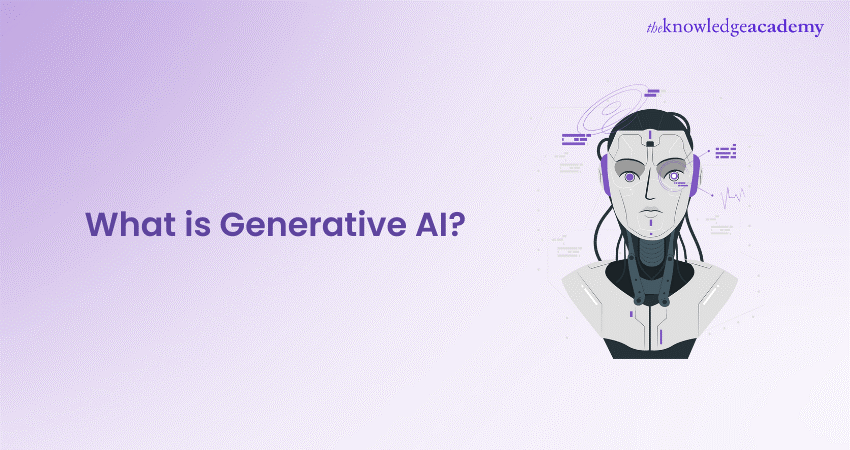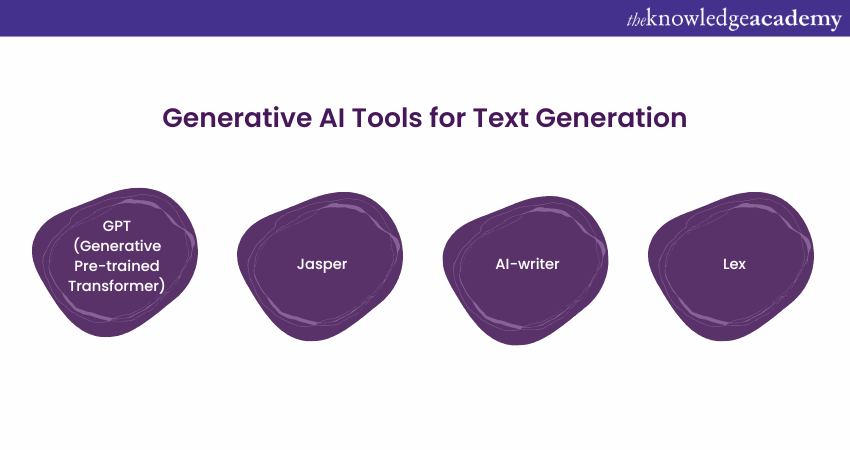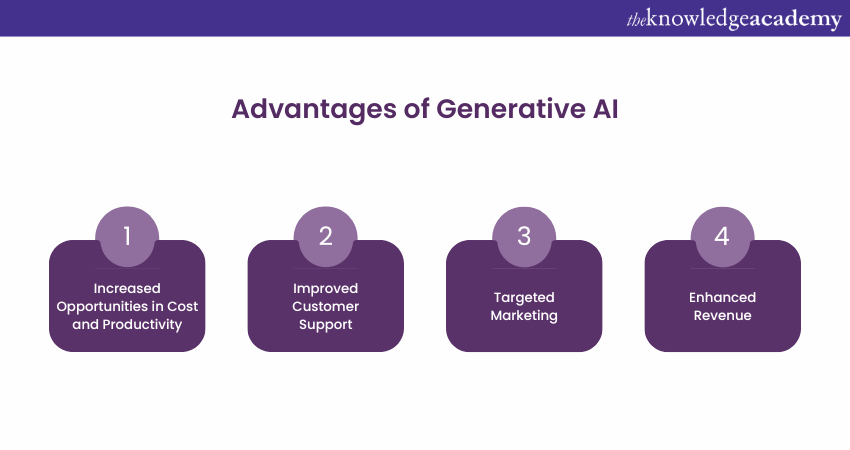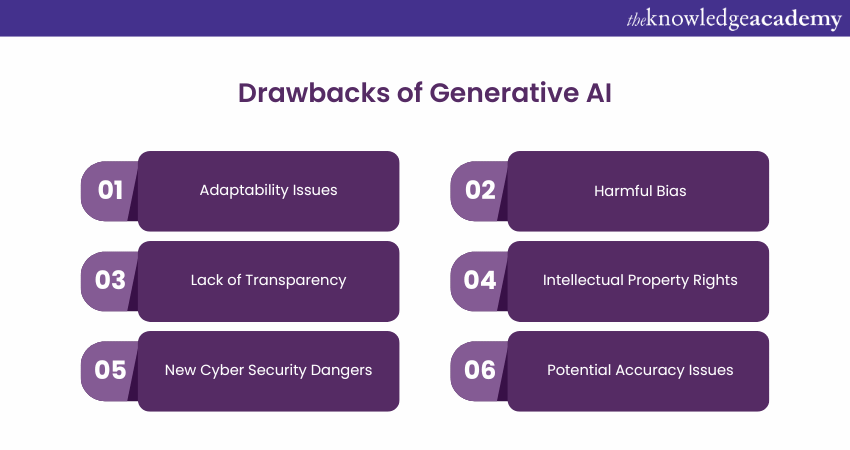We may not have the course you’re looking for. If you enquire or give us a call on +353 12338944 and speak to our training experts, we may still be able to help with your training requirements.
We ensure quality, budget-alignment, and timely delivery by our expert instructors.

Imagine a world where AI joins hands with human creativity to conjure stunning artwork, write captivating stories, and compose mesmerising music—all from scratch! This isn't science fiction anymore; this is the genuine magic of Generative AI. Understanding What is Generative AI is vital for modern creative minds to explore new artistic frontiers. In fact, the global Generative AI market size is expected to grow to nearly £17.6 billion by 2032.
Unlike traditional AI, which focuses on recognising patterns and making predictions, Generative AI learns from vast datasets to deliver original, creative outputs. This technology is revolutionising industries, from entertainment and art to finance and healthcare, accomplishing tasks such as crafting lifelike images and music compositions to generating text and 3D models. This blog delves into What is Generative AI, encompassing its features, advantages, future and more. Let's dive in!
Table of Contents
1) What is Generative AI?
2) How Does Generative AI Work?
3) How to Develop Generative AI Models?Some Examples of Generative AI Tools
4) Some Examples of Generative AI Tools
5) Use Cases for Generative AI
6) Advantages Generative AI Offer
7) Drawbacks of Generative AI
8) What are Foundational Models in Generative AI?
9) What is the Difference Between AI and Generative AI?
10) Conclusion
What is Generative AI?
Water Jug Problem in AI is a fascinating challenge that demonstrates the versatility of Generative Artificial Intelligence (Gen AI), which is a category of AI designed to create new content and ideas, including stories, images, videos, conversations, and music. It can learn art, chemistry, biology, human language, programming languages, or any other complex subject matter.
It reuses what it knows (and is trained with) to solve new problems. For instance, it can learn English vocabulary and generate a poem from the words it processes. Your organisation can leverage Generative AI for various purposes, such as media creation, chatbots, product development, and design.
How Does Generative AI Work?
Like all forms of Artificial Intelligence, Generative AI uses Machine Learning models pre-trained on vast amounts of data. These models can be categoried as the following:
1) Foundation Models: Foundation models are ML models trained on a broad spectrum of generalised and unlabelled data. They're capable of a wide variety of general tasks. Consider these examples:
a) In the case of image generation, the model analyses the image and generates a sharper, more clearly defined version.
b) With text, the model predicts the next word in a text string based on previous words and their context. Then, it selects the next word using probability distribution techniques.
2) Large Language Models (LLMs): LLMs are one class of foundation models. For instance, OpenAI's Generative Pre-trained Transformer (GPT) models are LLMs. These models are focused explicitly on language-based tasks such as such as:
a) Summarisation
b) Text generation
c) Text classification
d) Open-ended conversation
e) Information extraction
Understand the role of GANs, VAEs and other models for threat detection with our Generative AI in Cybersecurity Training!
How to Develop Generative AI Models?
Multiple Types of Generative AI exist, and combining the positive attributes of each can create even more powerful models. Let's explore them in detail:

1) Diffusion Models: Also named Denoising Diffusion Probabilistic Models (DDPMs), diffusion models determine vectors in latent space through a two-step process during training: Forward and reverse diffusion.
a) Forward Diffusion: This process slowly adds random noise to training data.
b) Reverse Diffusion: This process reverses the noise to reconstruct the data samples.
Thanks to this two-step process, hundreds of layers can be trained, which helps diffusion models deliver the best quality output when building Generative AI models.
2) Variational Autoencoders (VAEs): VAEs comprises of two neural networks, the encoder and decoder. An encoder converts the input into a more miniature, dense data representation. This compressed representation preserves the information required for a decoder to rebuild the original input data while eliminating irrelevant information.
The encoder and decoder work in tandem to learn an efficient and straightforward latent data representation. This enables the user to sample new latent representations with ease, that can be mapped through the decoder to generate novel data.
3) Generative Adversarial Networks (GANs): GANs were the most used methodology out of these three before the recent success of diffusion models. GANs provide a strong example of Adversarial Search in Artificial Intelligence in practice, pitting these two neural networks against each other:
a) Generator: This network generates new examples.
b) Discriminator: This network can distinguish the generated content as either fake (generated) or real (from the domain).
Some Examples of Generative AI Tools
The following provides each category of Generative AI Tools:
1) Text Generation
Text generation tools have witnessed significant advancements, allowing users to create human-like text content. The following are the prominent choices:

1) Generative Pre-trained Transformer (GPT): GPT stands out as a state-of-the-art model capable of generating coherent and contextually relevant text based on input prompts. Its extensive pre-training on diverse datasets empowers it to handle various language tasks effectively.
2) Jasper: Known for its prowess in Natural Language Processing (NLP), Jasper is a text generation tool that excels in producing articulate and contextually rich textual output, making it valuable for applications requiring coherent language generation.
3) AI-Writer: This tool focuses on delivering high-quality automated content creation. AI-Writer is designed to generate articles, blog posts, and other written content, offering users a versatile solution for text generation.
4) Lex: Lex is another noteworthy text generation tool, allowing users to create engaging and contextually relevant written content. Its features make it suitable for various applications, from Creative Writing to content automation.
Image Generation
Image generation tools leverage advanced Neural Networks to create novel visual content. Notable tools in this domain include:
1) Dall-E 2: As a successor to the original DALL-E, Dall-E 2 is a cutting-edge image generation tool that employs generative models to create unique and imaginative visuals based on textual prompts. It pushes the boundaries of what is possible in AI-generated imagery.
2) Midjourney: Midjourney is recognised for its ability to generate visually appealing images with a focus on artistic creativity. This tool is widely popular among artists and designers seeking AI assistance in producing visually stunning and original compositions.

3)Stable Diffusion: This image generation tool specialises in creating stable, high-quality images through diffusion models. It enhances image synthesis by offering enhanced stability in the generated visuals.
Gain knowledge of interpretability with our Generative AI Prompt Engineering Training - Register now!
Music Generation
AI-powered music generation tools bring innovation to the creative process of composing music. Some noteworthy tools include:
1) Amper: Amper is an AI-driven music composition tool enabling users to carft original music tracks effortlessly. Its intuitive interface and adaptive algorithms make it accessible to musicians and non-musicians.
2) Dadabots: Dadabots explores the intersection of AI and music by utilising neural networks to generate unique and experimental music compositions. It appeals to those interested in pushing the boundaries of traditional music creation.
3) MuseNet: Renowned for its versatility, MuseNet is a music generation tool capable of creating compositions across various genres and styles. It empowers users to experiment with different musical elements, fostering creativity and exploration.
Code Generation
AI tools for code generation streamline the software development process. Key players in this space include:
1) CodeStarter: CodeStarter assists developers in kickstarting their coding projects by generating boilerplate code and providing a foundation for further development. This tool is beneficial for speeding up the initial stages of software development.
2) Codex: Codex is a powerful code generation tool that leverages machine learning (ML) to understand and replicate developers' coding patterns. It enhances productivity by suggesting relevant code snippets and solutions during coding.
3) GitHub Copilot: Developed in collaboration with OpenAI, GitHub Copilot is an intelligent code completion tool that uses machine learning (ML) to suggest entire lines or blocks of code based on the developer's input. It significantly accelerates the coding workflow by providing context-aware suggestions.
4) Tabnine: Tabnine is an AI-driven code completion tool that integrates with popular code editors. It utilises Machine Learning to predict and suggest code snippets, making the coding experience more efficient and reducing the need for manual typing.
Learn about Chatbot customisation and deployment in our comprehensive ChatGPT Course - Sign up now!
Voice Synthesis
Voice synthesis tools employ AI to generate natural-sounding, synthetic voices. Notable tools in this category include:
1) Descript: Descript offers advanced voice synthesis capabilities, allowing users to create natural-sounding voiceovers and audio content. Its user-friendly interface makes it accessible for various applications, from podcast production to video narration.
2) Listnr: Listnr stands out as a tool that combines AI-driven voice synthesis with analytics, enabling users to convert text into lifelike speech and gain insights into audience engagement with audio content.
3) Podcast.ai: Explicitly designed for podcast creators, Podcast.ai utilises AI to generate engaging and professional-sounding voice content. It enhances the podcasting experience by providing a convenient and efficient solution for voice synthesis in the audio production workflow.
AI Chip Design
Several companies play a vital role in shaping the hardware landscape in AI chip design. Noteworthy entities include:
1) Synopsys: Synopsys is a leading electronic design automation (EDA) software and hardware solutions provider. In the context of AI, Synopsys contributes to developing specialised chips through its EDA tools, ensuring efficiency and reliability in the design process.
2) Cadence: Cadence is renowned for its comprehensive set of tools for electronic design, including those tailored for AI chip design. Its solutions cover various aspects of the design flow, from verification to implementation, supporting the creation of high-performance AI hardware.
3) Google: Google, a tech giant with a significant presence in AI research, is actively involved in designing and developing AI hardware. The company aims to optimise hardware architectures for its AI algorithms, enhancing AI applications' overall performance and efficiency.

4) Nvidia: As a key player in the graphics processing unit (GPU) market, Nvidia has gained prominence in AI chip design. Its GPUs are widely used for accelerating AI workloads, and the company continues to innovate in hardware design to meet the increasing demands of AI applications.
Stay ahead of the learning curve with our Artificial Intelligence Tools Training !
Use Cases for Generative AI
New Generative AI technologies have been likened to historical general-purpose innovations such as steam power, electricity, and computing, given their potential to significantly impact various industries and applications. It is crucial to note that, like their predecessors, the optimal organisation of workflows to harness the full potential of these new technologies may take years to refine. Consider the following provides use cases for Generative AI:
1) In Finance, Generative AI can revolutionise fraud detection systems by closely monitoring transactions within the context of an individual's history, thereby enhancing accuracy and security.
2) Legal firms stand to benefit by employing Generative AI in creating and interpreting contracts, as well as the analysis of evidence and formulating compelling legal arguments.
3) Manufacturers, utilising Generative AI, can amalgamate data from diverse sources such as cameras and X-ray scans to pinpoint defective parts with greater precision and at a lower cost, thereby effectively addressing issues at their root causes.
4) Film and media companies can leverage Generative AI to streamline content production processes, making them more cost-effective. Additionally, this technology can facilitate content translation into multiple languages while preserving the actors' original voices.
5) In the medical industry, Generative AI can expedite the identification of promising drug candidates, contributing to more efficient drug discovery processes.
6) Architectural firms can enhance their design processes by incorporating Generative AI, enabling quicker prototyping and adaptation of designs.
7) Gaming companies stand to benefit from the use of Generative AI in creating game content and levels, fostering innovation and efficiency within the gaming industry.
Dive into the world of AI with our comprehensive Generative AI PDF. Download it now to explore cutting-edge AI technologies and applications!
Advantages Generative AI Offer
With its ability to create accurate, intelligent and original content with minimal help from human operators, Generative AI brings numerous benefits to businesses across various sectors. Generative models have the potential to catalyse innovation and unlock new opportunities by leveraging the AI's creative power. Key business benefits of Generative AI include:

1) Increased Opportunities in Cost and Productivity: Generative AI is a game-changer in optimising processes, automating tasks, and reducing operational costs. It enhances efficiency in areas such as content creation, design optimisation, and predictive maintenance.
By automating tasks that were once time-consuming and demanded constant creative input, businesses can increase productivity, save resources, and free up valuable professionals for more strategic endeavours. This relieves them of the burden of repetitive tasks.
2) Improved Customer Support: Traditionally, customer support relied on direct one-on-one interaction, with agents having to devote their entire attention towards resolving individual customer issues. Generative AI allows businesses to deploy AI-powered virtual assistants and chatbots that can assist with queries, offer solutions, and even discuss purchasing options.

By automating Customer Service, businesses can improve overall customer experiences, reduce costs, and enable the human agents to achieve more in less time.
3) Targeted Marketing: Generating personalised content, creating targeted advertising campaigns and sharing optimised product recommendations based on customer preferences and behaviour—Generative AI offers significant benefits in marketing. By delivering marketing strategies customised to individual buyers, organisations enjoy more customer engagement, improved conversion rates and stronger brand loyalty.
4) Enhanced Revenue: Generative AI is not just about improving processes and customer service. It's about increasing company revenue. The advantages listed above, from opening new opportunities to creating advanced products and services at lower cost, all contribute to greater financial success. Generative AI is a potent tool for increasing revenue and securing the financial future of your business.
Acquire skills in requirements elicitation documentations for validation implementation with Generative AI For Business Analyst Training today!
Drawbacks of Generative AI
Generative AI carries immense potential for optimising and streamlining business processes and personalising customer interactions. However, it is worth recognising that Generative AI has its share of risks and limitations. Here are some potential drawbacks associated with Generative AI that you need to be aware of:

1) Adaptability Issues: Generative AI models may need help tuning their outputs to new circumstances. This requires constant fine-tuning and adjustment to ensure it stays relevant and accurate.
2) Harmful Bias: Since Generative AI models are built upon the foundation of data, they may inherit certain biases from that training data into their outputs. Organisations must have policies to detect and address biased content to avoid inadvertently spreading harmful preconceptions.
3) Lack of Transparency: The focus on ease of use and conversation-like input/output certainly has its upsides. But it has created an environment where it takes time to understand exactly How Does Generative AI Work and the source of its original data. Many organisations might not opt for Generative AI without having a clearer picture of its inner workings.
4) Intellectual Property Rights: Despite the advanced nature of today's Generative AI, they still need training on available data to produce content. This creates murky waters especially regarding copyrighted materials since AIs may be using intellectual property that doesn't belong to their parent organisation. Meanwhile, users who share confidential information with AIs may discover that the data's confidentiality has been lost by becoming part of the AI data set.
5) New Cyber Security Dangers: Cyber criminals are already using Generative AI programs to circumvent security layers and target their victims more effectively. Attackers may even utilise the vulnerabilities of company-based AIs as system entry points to gain access to sensitive data. Keeping current on cyber security advancements and vulnerability patches is the only way to battle these growing threats.
6) Potential Accuracy Issues: One major problem associated with Generative AI systems is that they may make up answers in what is referred to as Generative AI 'hallucinations'. It is vital to carefully assess the outputs for accuracy and usefulness before publicly distributing any information created by a Generative AI.
Attain knowledge of AI driven Software Development principles and strategies with our Generative AI in Software Development Course!
What are Foundation Models in Generative AI?
Foundation models are big Generative AI models trained on a broad spectrum of image and text data. They can perform general tasks like writing essays, answering questions, and captioning images.
What is the Difference Between AI and Generative AI?
Unlike traditional AI systems, which are programmed with specific algorithms and rules, Generative AI systems are trained on vast datasets. They learn to generate new content by identifying patterns and creating new variations around them.
Conclusion
In conclusion, Generative AI empowers users to swiftly produce novel content by leveraging diverse inputs. These models can handle inputs such as text, images, sounds, animation, 3D models, and various other forms of data, offering a versatile and dynamic tool for creative endeavours. Gaining deeper insight into What is Generative AI as detailed in this blog will guide you towards integrating Generative AI into your creative process
Learn the core principles of deep learning with our Generative AI Course!
Frequently Asked Questions
What is the Future of Coding After ChatGPT?

Generative AI democratises coding and makes it accessible to a broader audience, from beginners to experts. Developers can leverage AI for speedy prototyping, debugging, and code suggestions.
What is the Difference Between OpenAI and Generative AI?

Generative AI can develop personalised materials, adapt to individual learning styles, and provide real-time feedback. Meanwhile, OpenAI's commitment to fairness ensures that these AI-driven tools are unbiased and promote equal opportunities for all users.
What are the Other Resources and Offers Provided by The Knowledge Academy?

The Knowledge Academy takes global learning to new heights, offering over 3,000 online courses across 490+ locations in 190+ countries. This expansive reach ensures accessibility and convenience for learners worldwide.
Alongside our diverse Online Course Catalogue, encompassing 19 major categories, we go the extra mile by providing a plethora of free educational Online Resources like News updates, Blogs, videos, webinars, and interview questions. Tailoring learning experiences further, professionals can maximise value with customisable Course Bundles of TKA.
What is The Knowledge Pass, and How Does it Work?

The Knowledge Academy’s Knowledge Pass, a prepaid voucher, adds another layer of flexibility, allowing course bookings over a 12-month period. Join us on a journey where education knows no bounds.
What are the Related Courses and Blogs Provided by The Knowledge Academy?

The Knowledge Academy offers Artificial Intelligence Tools Training, including the ChatGPT Prompt Engineering Certification Course and the AI Tools in Performance Marketing Training. These courses cater to different skill levels, providing comprehensive insights into Prompt Engineering Best Practices.
Our Data, Analytics & AI Blogs cover a range of topics related to offering valuable resources, best practices, and industry insights. Whether you are a beginner or looking to advance your AI knowledge, The Knowledge Academy's diverse courses and informative blogs have got you covered.
Upcoming Data, Analytics & AI Resources Batches & Dates
Date
 Generative AI in Software Development Training Course
Generative AI in Software Development Training Course
Fri 4th Apr 2025
Fri 6th Jun 2025
Fri 8th Aug 2025
Fri 3rd Oct 2025
Fri 5th Dec 2025






 Top Rated Course
Top Rated Course



 If you wish to make any changes to your course, please
If you wish to make any changes to your course, please


